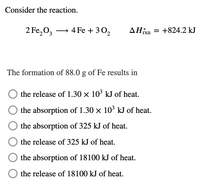
Chemistry
10th Edition
ISBN: 9781305957404
Author: Steven S. Zumdahl, Susan A. Zumdahl, Donald J. DeCoste
Publisher: Cengage Learning
expand_more
expand_more
format_list_bulleted
Concept explainers
Question

Transcribed Image Text:Consider the reaction.
2 Fe,0, → 4 Fe + 3 0,
AHixn
= +824.2 kJ
The formation of 88.0 g of Fe results in
the release of 1.30 × 10' kJ of heat.
the absorption of 1.30 x 10' kJ of heat.
the absorption of 325 kJ of heat.
the release of 325 kJ of heat.
the absorption of 18100 kJ of heat.
the release of 18100 kJ of heat.
Expert Solution
This question has been solved!
Explore an expertly crafted, step-by-step solution for a thorough understanding of key concepts.
This is a popular solution
Trending nowThis is a popular solution!
Step by stepSolved in 3 steps

Knowledge Booster
Learn more about
Need a deep-dive on the concept behind this application? Look no further. Learn more about this topic, chemistry and related others by exploring similar questions and additional content below.Similar questions
- 26. Calculate the enthalpy change for the reaction below. NO(g) + O(g) →→→ NO₂(g) Given following data: NO(g) + O₂(g) →→ NO₂(g) + O₂(g) 03(g) → 1.50₂(g) 0₂(g) →20(g) AH-198.9 kJ AH = -142.3 kJ ΔΗ = 495.0 kJarrow_forwardA 5.71 g sample of an unknown salt (MM = 116.82 g/mol) is dissolved in 150.00 g water in a coffee cup calorimeter. Before placing the sample in the water, the temperature of the salt and water is 23.72 °C. After the salt has completely dissolved, the temperature of the solution is 28.54 °C. Was the dissolution process endothermic or exothermic?arrow_forwardExplain step by step why each can or cannot occur.arrow_forward
- 22. A 44.97−g sample of water at 72.2°C is added to a sample of water at 25.7°C in a constant-pressure calorimeter. If the final temperature of the combined water is 38.4°C and the heat capacity of the calorimeter is 26.3 J/°C, calculate the mass of the water originally in the calorimeter.arrow_forwardConsider the reaction. 2Fe2O3⟶4Fe+3O2 Δ?∘rxn=+824.2 kJ The decomposition of 74.0 g of Fe2O3 results in A.) the release of 382 kJ of heat. B.) the absorption of 191 kJ of heat. C.) the release of 191 kJ of heat. D.) the absorption of 30500 kJ of heat. E.) the release of 30500 kJ of heat. F.) the absorption of 382 kJ of heat.arrow_forwardThe reaction below is a exothermic or endothermic reaction. 2SO3(g) + Heat ⇋ 2SO2(g) + O2(g)arrow_forward
- A 3.000 g sample of food was then burned in a calorimeter to determine its Calories per gram content. 50mL of water were used to determine ΔT of the reaction. Initial temperature of the water at the start of the combustion reaction was 20oC, final temperature was 99oC. Calorimeter constant for this calorimeter is 10.0J/oC. How much heat has been absorbed by the water sample?arrow_forward3.76 g of MgSO4 is placed into 100.0 mL of water. The water's temperature increases by 6.70 °C. Calculate AH, in kJ/mol, for the dissolution of MgSO4. (The specific heat of water is 4.184 J/g °C and the density of the water is 1.00 g/ mL). You can assume that the specific heat of the solution is the same as that of water.arrow_forward15. The enthalpy change for the reaction CH,(g) + 20,(g) CO,(g) + 2H,O() is -891 kJ for the reaction as written. a. What quantity of heat is released for each mole of water formed? b. What quantity of heat is released for each mole of oxygen reacted?arrow_forward
- In a coffee cup calorimeter with a heat capacity of 21.5 J/ºC, 225 mL of 0.20 M KOH at 22.3 ºC neutralizes 225 mL of 0.20 M HCl at 22.3 ºC. After the reaction occurs, the temperature of the resulting mixture is 29.2 ºC. The density of the final solution is 1.00 g/mL and the specific heat is 4.18 J/g°C. Calculate the Heat of neutralization of KOH.arrow_forwardWhen a 0.740-g sample of trinitrotoluene (TNT), C,H,N,O, is burned in a bomb calorimeter, the temperature increases from 23.4 °C to 26.9 °C. The heat capacity of the calorimeter and its content is 3.35 kJ/°C. How much heat was produced by the combustion of the TNT sample? O 34.2 kJ O 11.7 kJ O 101.5 kJarrow_forwardConsider the reaction. 2 Fe,O, 4 Fe + 30, AHn = +824.2 kJ The formation of 84.0 g of Fe results in the absorption of 3.10 x 102 kJ of heat. the absorption of 17300 kJ heat. the absorption of 1240 kJ of heat. the release of 1240 kJ of heat. the release of 3.10 x 10² kJ of heat. the release of 17300 kJ of heat. G Search or type URLarrow_forward
arrow_back_ios
SEE MORE QUESTIONS
arrow_forward_ios
Recommended textbooks for you
 ChemistryChemistryISBN:9781305957404Author:Steven S. Zumdahl, Susan A. Zumdahl, Donald J. DeCostePublisher:Cengage Learning
ChemistryChemistryISBN:9781305957404Author:Steven S. Zumdahl, Susan A. Zumdahl, Donald J. DeCostePublisher:Cengage Learning ChemistryChemistryISBN:9781259911156Author:Raymond Chang Dr., Jason Overby ProfessorPublisher:McGraw-Hill Education
ChemistryChemistryISBN:9781259911156Author:Raymond Chang Dr., Jason Overby ProfessorPublisher:McGraw-Hill Education Principles of Instrumental AnalysisChemistryISBN:9781305577213Author:Douglas A. Skoog, F. James Holler, Stanley R. CrouchPublisher:Cengage Learning
Principles of Instrumental AnalysisChemistryISBN:9781305577213Author:Douglas A. Skoog, F. James Holler, Stanley R. CrouchPublisher:Cengage Learning Organic ChemistryChemistryISBN:9780078021558Author:Janice Gorzynski Smith Dr.Publisher:McGraw-Hill Education
Organic ChemistryChemistryISBN:9780078021558Author:Janice Gorzynski Smith Dr.Publisher:McGraw-Hill Education Chemistry: Principles and ReactionsChemistryISBN:9781305079373Author:William L. Masterton, Cecile N. HurleyPublisher:Cengage Learning
Chemistry: Principles and ReactionsChemistryISBN:9781305079373Author:William L. Masterton, Cecile N. HurleyPublisher:Cengage Learning Elementary Principles of Chemical Processes, Bind...ChemistryISBN:9781118431221Author:Richard M. Felder, Ronald W. Rousseau, Lisa G. BullardPublisher:WILEY
Elementary Principles of Chemical Processes, Bind...ChemistryISBN:9781118431221Author:Richard M. Felder, Ronald W. Rousseau, Lisa G. BullardPublisher:WILEY

Chemistry
Chemistry
ISBN:9781305957404
Author:Steven S. Zumdahl, Susan A. Zumdahl, Donald J. DeCoste
Publisher:Cengage Learning

Chemistry
Chemistry
ISBN:9781259911156
Author:Raymond Chang Dr., Jason Overby Professor
Publisher:McGraw-Hill Education

Principles of Instrumental Analysis
Chemistry
ISBN:9781305577213
Author:Douglas A. Skoog, F. James Holler, Stanley R. Crouch
Publisher:Cengage Learning

Organic Chemistry
Chemistry
ISBN:9780078021558
Author:Janice Gorzynski Smith Dr.
Publisher:McGraw-Hill Education

Chemistry: Principles and Reactions
Chemistry
ISBN:9781305079373
Author:William L. Masterton, Cecile N. Hurley
Publisher:Cengage Learning

Elementary Principles of Chemical Processes, Bind...
Chemistry
ISBN:9781118431221
Author:Richard M. Felder, Ronald W. Rousseau, Lisa G. Bullard
Publisher:WILEY